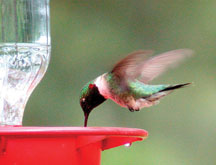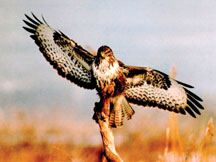|
observer |
|
|
|
|
|
OTHER LINKS |

|

|

|
|
|
|
|
We know that birds cannot fly without wings even though the rest of their bodies are made for flying. But, how do wings actually work? In order to know this, we need to first look at a cross-section of a bird's wing which will reveal that the wing is shaped rather like a very flattened oval, rounded at the front edge, but more tapering and pointed at the rear. You will also notice that the entire wing is slightly curved.
This shape of the wing is known as aerofoil. Did you know that many years ago scientists copied this shape when they were designing wings for aircraft?
So, it is evident that the shape of a bird's wing plays a key role in keeping a bird up in the air. As the upper surface of the wing is raised in a curve, air travelling across it has to move faster than air moving under the wing.
The first humans to discover how this aerofoil section works (see box) were the Australian Aborigines when they invented the boomerang (about which we featured recently in the Science page).
How shape affects flight patterns
|
|
The shape of a bird's wing determines how it flies. Even though the general shape (aerofoil) is maintained, the overall shape of wings in different species of birds changes, depending on how each species needs to fly.
For instance, fast flight demands narrow wings, like those of swallows, while for quick flight in woodlands, short rounded wings are needed, like the wings seen on a bluetit.
Falcon's wings change shape from long and narrow for fast flight, to swept-back for diving at top speed. Birds such as gannets have long wings for long distance flight and gliding; when they dive to catch fish, the long wings are folded backwards, like the flights of a dart.
*****
The four basic wing shapes
The shape of a wing enables us to get an idea as to how a bird flies.
Agile - This type of wings which are short and rounded are ideal for manoeuvring in restricted spaces. Perching birds such as finches and thrushes have agile wings.
Gliding - These wings are longer and not as broad as they are long. This type of wings allow birds such as albatrosses and frigate birds to glide effortlessly on the gentlest air currents. High speed - The jet fighters of the bird world such as the falcons and ducks have high speed wings which are pointed and short.
Soaring - Long, rectangular shaped with deep slots between the feathers of the wing tip, this type of wings enable eagles, vultures, storks and pelicans to ride thermals (heat waves).
The ratio of the length of the wings to its width is called the aspect ratio.
****
How a bird's wing works...
We have explained how a bird's wing is shaped and that it's known as an aerofoil. This is how the aerofoil functions to keep the bird up in the air...
Lift - When air flows over an aerofoil, the shape causes the air to travel faster over the top than over the bottom. This causes a difference in pressure between the top and bottom of the aerofoil, which in turn makes the air beneath the aerofoil or wing rise, pushing the bird upwards as it moves across the air.
The part of the bird's wing responsible for creating this lift, its flight muscles, lie between the body and elbow. As the bird flaps its wings and rises, the rest of the wing is used mainly to push the bird forwards through the air.
Close fit feathers - The manner in which the feathers are placed on the wing and the rest of its body too matter a lot when it comes to flying. All the feathers fit together very precisely, creating a smooth surface. Why is a smooth surface so important? Because, it is necessary for the bird to move through the air without causing turbulence, which would seriously impair its flight.
During flight, birds adjust the angle of their wings to control lift, which is only a part of the process of flying.
****
The power behind lift and take-off

How does a bird get off the ground, you may have often wondered. Birds have a natural machine which helps them with power in lift and take-off. The inside organs which are different to ours, run at high speed. Birds have air sacs next to the lungs that make them never run out of breath, a heart that beats faster than any other animal's and temperature that's higher than man's.
A bird's muscles also play a key role when it comes to take-off. Flight muscles provide the power needed in lift and take-off, as much as the feathers, wings, the light bones and everything else. But, these are all part of the bird's body.
Let's see what external things come into play for a bird to get off the ground. Well, a bird also uses the different air pressure above and below the wings to get off the ground. However, to understand the way a bird does this, we need to know what air pressure is.
You may be aware that air has weight even though you cannot see it. The gas molecules that make up air exerts pressure on everything around them. Slow-moving air exerts more pressure than fast-moving air. Air in a high-pressure area always moves towards a low-pressure area.
A bird uses the different wind conditions to propel itself through the air and also get lift. Wind currents called updrafts are used by birds to soar, saving themselves the energy needed to rise higher by flapping their wings. Then, they also use another wind condition known as thermal to soar higher and higher into the skies.
****
How a bird lands...

Landing is not easy, especially when the bird is trying to perch on a tree or a narrow space. If the bird lands too quickly, it will topple over, and if it lands too slowly, it will miss the branch, and end up somewhere else. So, the bird uses its tail and the wing tips to control its landing.
The tail is generally like a rudder. It helps the bird to steer. When landing, it is used as the brakes.
****
Fact file
* Feathers do not grow all over the body. They grow on feather tracks. Down feathers grow in between the feather tracks.
* Feathers are light, but some birds have bones that weigh less than their feathers. Bird bones are most often hollow. Birds have less bones.
|
|
* These bones are designed specifically to allow them to achieve lift more easily.
* When a bird flaps its wings, the primary feathers act like a propeller of an aeroplane.
* Over 30 per cent of a hummingbird's weight is in its flight muscles.
* The flapping motion is one of the most strenuous activities in the entire animal kingdom. The Ruby-throated hummingbird is said to flap its wings about 80 times per second, a Tit about 25-27 wing beats per second and a Mockingbird about 14 wing beats per second.
* Flying is more demanding than even running, and birds use a great amount of energy for flight. To fuel their muscles, birds eat high energy foods and store much of the energy as fat.
* Flight muscles are attached to the bird's skeleton in the breast area and are of two types: strong muscles with lots of blood vessels which are darker in colour and help sustained flight, and lighter coloured muscles which are used for quick explosive flight. Flight muscles have to be strong because they need to lift a bird's entire body weight into the air.
* Many migratory ducks and water fowl fly less than 200 feet above the waves, while birds such as geese and cranes fly at about 30,000ft above sea-level.










